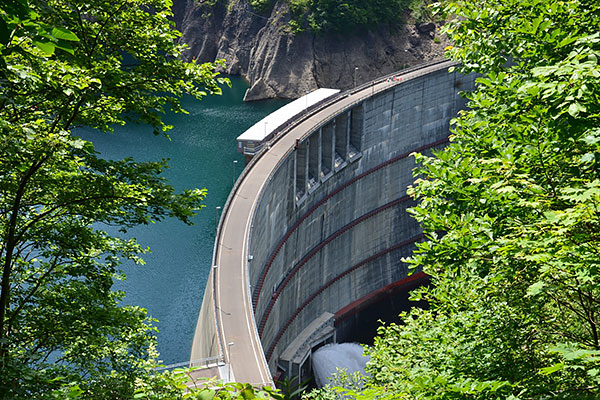
Photograph source:Association for Civil Engineering Technology of Hokkaido Concrete Research Committee
| Structure name | Hoheikyo DAM |
|---|---|
| Structure type | Arch dam |
| Purpose | Flood control、Water supply for city water、Hydropower |
| Structural factors | Height102.5m、Crest length305.0m、Volume285×10³m³、Ponding area150ha、Total reservoir capacity47,100×10³m³ |
| Operator | Hokkaido Regional Development Bureau Development and Construction |
| Designer | Hokkaido Regional Development Bureau Development and Construction |
| Contractor | Taisei Co. 、 Iwata Chizaki Co.,Ltd |
| Location | Sapporo city |
| River system | Ishikari River/Toyohira River |
| Completion date | 1973 |
| Overview | The Hoheikyou Dam is a parabolic arch concrete dam, with a bank height of 102.5 meters and a top bank length of 305.0 meters. The arch concrete dam is a structure with a semicircular or parabolic shape when viewed from above, and the hydraulic load from the lake is transmitted to the rock of both banks by the arch action. It is thus necessary that the rock on both banks be hard and durable, but this allows for the thickness of the dam structure itself to be reduced, which can reduce the total amount of concrete. The Okuniikappu Dam is another example of an arch dam in Hokkaido. The original topography of the dam site featured exposed rocks in a v-shape on both the left and right banks, so initially both gravity and arch dam types were considered. However, subsequent investigation found a weak layer in the riverbed, so the parabolic arch type was adopted because it transmits most of the stress to the banks. This was considered to be more advantageous both economically and technologically when compared to the gravity dam, which would concentrate stress in the weak layer. Moderate heat portland cement was used in the concrete. Since the shear strength in the weak layer of the riverbed was insufficient for a thin arch, the dam was designed with a separate saddle from the lowest elevation of 375.0 meters to 400.0 meters. At that time, under the guidance of the Ministry of Construction’s Public Works Research Institute, stress analysis and model experiments were carried out. Additionally, the rock shear test was carried out at 27 locations and the flat loading test at 79 locations, and these test results were reflected in the design. |

